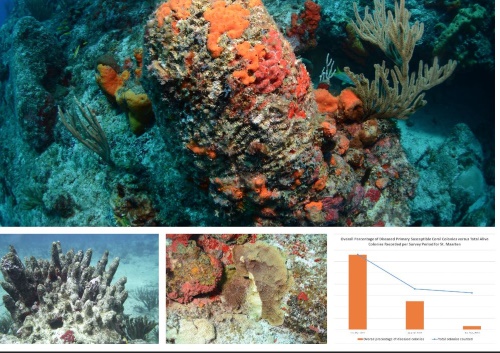 PHILIPSBURG:--- The Nature Foundation St. Maarten is very concerned about the state of the local coral reefs, which is one of the most important ecosystems for St. Maarten; as it is providing coastline protection from storms, delivering clear waters, a home for fishes and it is an important tourist attraction. Over the last two years, many coral colonies have died and disappeared from St. Maarten reefs, leaving bare coral skeletons behind. A relatively new coral disease ‘Stony Coral Tissue Loss Disease’ (SCTLD) was first discovered in 2018 on St. Maarten reefs and since then the disease has been monitored by the Nature Foundation in order to determine its impact over time. The Foundation believes that the new coral disease and continuous wastewater input into the ocean is the major cause of the deterioration of local coral reefs, and increased protection for corals is needed!
PHILIPSBURG:--- The Nature Foundation St. Maarten is very concerned about the state of the local coral reefs, which is one of the most important ecosystems for St. Maarten; as it is providing coastline protection from storms, delivering clear waters, a home for fishes and it is an important tourist attraction. Over the last two years, many coral colonies have died and disappeared from St. Maarten reefs, leaving bare coral skeletons behind. A relatively new coral disease ‘Stony Coral Tissue Loss Disease’ (SCTLD) was first discovered in 2018 on St. Maarten reefs and since then the disease has been monitored by the Nature Foundation in order to determine its impact over time. The Foundation believes that the new coral disease and continuous wastewater input into the ocean is the major cause of the deterioration of local coral reefs, and increased protection for corals is needed!
“We are very concerned about the corals in our waters and have noticed a large decrease in their abundance over the past years. Worldwide, corals are facing tremendous threats, due to rising ocean temperatures, overfishing, and coastal development. St. Maarten adds several threats to corals due to pollution and high wastewater input, which could increase the vulnerability to diseases and act as a stressor for corals, leading to early coral fatalities. We depend on our coral reefs and we need to ensure their survival for the future, without corals we are more prone to storms and tourists will not visit when our coral reefs disappear. Increased protection for coral reefs is essential on St. Maarten and the government should move to increase the marine protected area to cover all coral reefs occurring around our island immediately, before it is to late” urged Melanie Meijer zu Schlochtern Manager of the Nature Foundation St. Maarten.
Recently, the Nature Foundation re-surveyed the impact of the (SCTLD) disease on St. Maarten coral reefs and discovered a large decrease in actively diseased coral colonies, but an increase in deceased bare coral skeletons. This indicates the major impact the disease has had on St. Maarten coral reefs. “Currently only eight active diseased coral colonies were found when surveying the six monitoring sites, which is an improvement as it shows the disease is slowing down on our coral reefs. However during the last surveys, in total much fewer alive coral colonies were recorded in 2.5 hours compared with the beginning of 2019, indicating many colonies succumbed to the disease already and are overgrown with algae and other marine life. Also, those coral species which are highly susceptible to the disease were found to have perished or their bare skeletons were recorded, such as maze corals (Meandrina meandrites) and pillar corals (Dendrogyra cylindrus). In addition, other susceptible species for the disease such as brain and star corals (Pseudodiploria, Diploria, and Orbicella genus), were found to be dead, all most likely due to the SCTLD disease and facilitated by poor water quality” continued Melanie Meijer zu Schlochtern.
The Foundation found an average of 3% infection rates of the primary susceptible corals for the disease on the sites around St. Maarten in the Summer of 2020, in the Autumn of 2019 25% of the susceptible species were found to be diseased and 66% in the Spring of 2019. The decrease in infection rates over time is probably due to that most ‘primary susceptible species’ already perished earlier in 2019 and less coral colonies are left in total. Lower density in corals leads to fewer transmissions to healthy corals and the alive corals currently left, maybe became already resistant to the disease.
During the recent surveys, the Foundation found hardly any coral colonies from the species which are marked by experts as ‘highly susceptible’ to the disease (such as maze and pillar corals), which indicates that these species already perished and have been overgrown by algae and other marine life. Infection rates by the disease were very high for St. Maarten corals in 2019, fortunately, it slowed down and certain colonies are surviving the disease, the high infection rate of this disease shows that St. Maarten corals could be more sensitive than in other areas.
The continuous input of wastewater, either directly released to the ocean or indirectly related to land-based sources, causes coral colonies to become more susceptible and vulnerable to diseases and other external threats. Corals are very fragile and sensitive, nutrient input due to wastewater is a large threat for corals and this is occurring abundantly on St. Maarten. The high infection rates of SCTLD disease clearly shows the vulnerability of St. Maarten corals. St. Maarten was one of the first Caribbean Nations (together with Jamaica and Mexican Caribbean) affected with this new disease, after its discovery in Florida in 2014. An active Port, including transshipment port and cruise ship terminal, may have caused SCTLD disease to arrive on St. Maarten early, via ballast water, urging the need of proper regulations and enforcement of discharging ballast water.
The Nature Foundation used the Roving Diver methodology in order to establish the impact of the Tissue Loss disease on coral reefs. During the research, scientific divers conduct a swim around the site, focusing on species that are primarily impacted by the disease outbreak, all stony coral species and their level of disease impact are being recorded. This research provides insight in the order in which species are affected, the rate of spread of the disease and the frequency across different coral reef sites.
Tissue loss disease (SCTLD) is a relatively new issue that has been plaguing coral reefs in the Atlantic Basin for the last few years. The coral reef disease manifests itself through the creation of white blotches on stony coral, eventually leading to the loss of tissue and eventual death in the coral colony. The disease affects 20 different coral species and is able to kill colonies within several weeks or months. The disease appears to be water borne and may potentially be spread by divers their gear according to the Florida Disease Advisory Committee. Nature Foundation advises scuba divers to soak their gear in a 1% bleach solution for 10 minutes, and rinse well after, especially when moving in between islands. Nature Foundation also advises all divers to be aware of their fins and to not touch any diseased or healthy coral; as you will transmit the disease to other corals!











